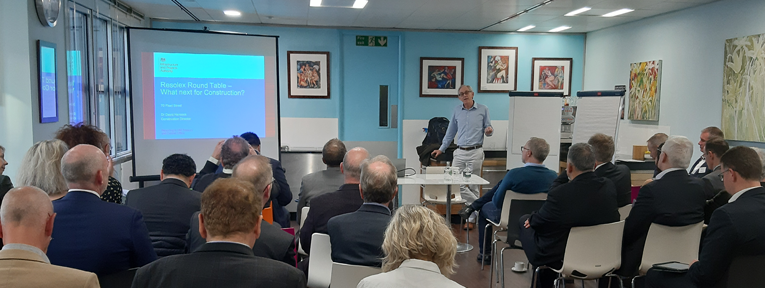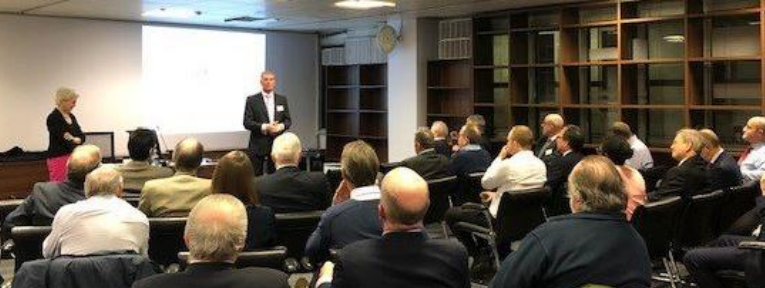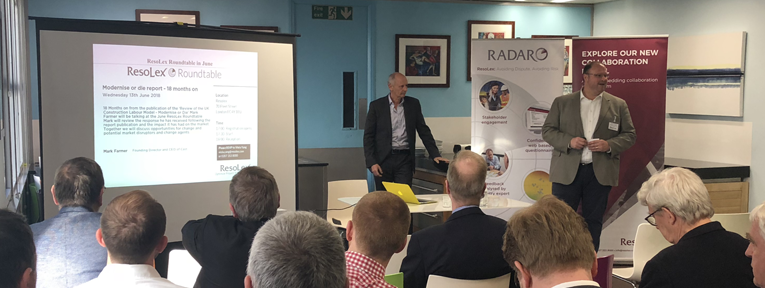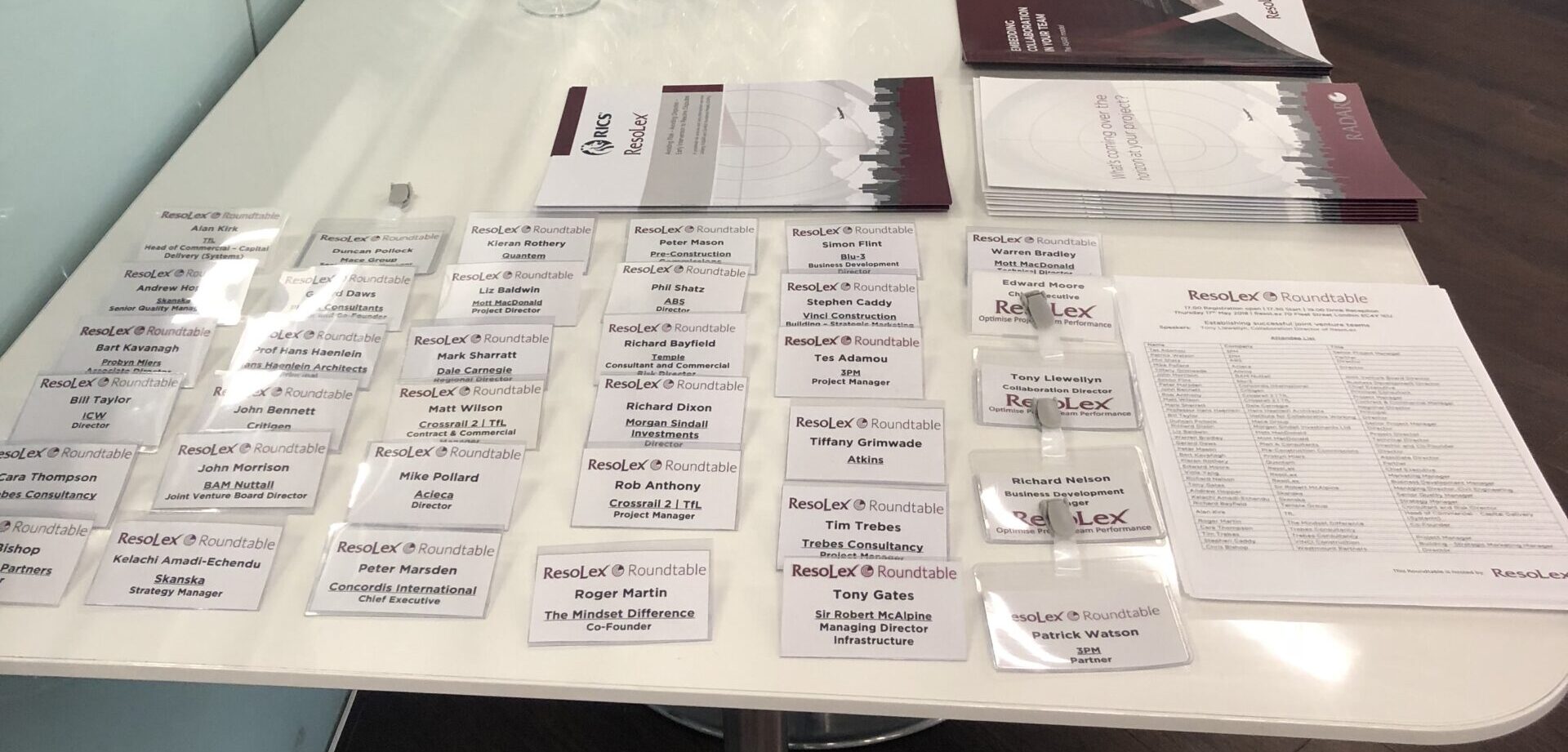
Jun 19, 2019 | Events, Roundtables
With Howard Britton
There are not many speakers who invite the audience at the very start of a presentation to regard him as obnoxious!
But Howard is not an ordinary presenter. With a wider and more varied career background than most, including a
period as a practicing Psychoanalyst, Howard is well qualified to provide a fresh perspective on the topic of diversity.
Howard invited us to join him on a journey of thought, which he divided into three parts.
PART ONE – TEAM ARCHETYPES
Howard suggested that there are four common character types that can be found in most teams.
TYPE 1 – THE ‘IDEAS’ PERSON This is an individual who is constantly thinking of new ways of doing things. People like this are typically regarded as mavericks.
TYPE 2 – THE ‘GRAVE DIGGER’ A person who seeks order and needs to sort everything into neat boxes.
TYPE 3 – THE ‘ENGINEER’ This is someone who loves process and believes in things being done in a particular and consistent sequence.
TYPE 4 – THE ‘DOER’ Someone who likes action and has limited patience with planning. She just wants to get things moving.
The inference as that the motivational drivers of everyone in a team will be influenced by factors that are little to do with
the work environment and are more likely to be shaped by their genetic wiring, as well as their childhood experiences.
Each will have a preference for the type of work they do.
The problem, however, is that most companies do not recognise these differences and often require people
to work in a way that is misaligned with their core drivers, leading to average or below-average performance. Howard then identified several leadership archetypes:
The ‘dense’ leader, who is highly egotistical, believes can do everyone’s job better than they can. This type of leader does not listen and therefore lacks real understanding of what is going on in his team.
The ‘empty’ leader, who has been overpromoted and is clueless as to how to do their job. Ideas and feedback from the team go into a void.
The invisible leader, who is rarely available to her staff, and whose focus is anywhere but on her team. She is continually travelling or in meetings.
The ’Socratic’ leader, who is clear that she doesn’t know everything. She is therefore continually listening to her team trying to understand them. This is the type of manager that is likely to get more productivity from members of her team.
Howard’s point is that in order to successfully manage the four archetypes within the team, leaders must work with their people at the level of their identity. He emphasised that individuals are unlikely to change and so the business must adapt to them to get the best out of them, although this is incredibly challenging.
PART TWO – HIGH PERFORMING TEAMS
Howard noted that in a volatile and uncertain world, many organisations are seeking a step change in how they
operate. This will require a change in organisational philosophy where leaders must identify their vision of a
future state and then work backwards to plan how to achieve it. He cited the example of Dale Evans at Anglian Water who declared a vision for a 50% reduction in carbon from the company’s capital expenditure programme. Dale did not
know how this target would be achieved but engaged the wider team in agreeing a series of steps that would lead to
the desired outcome. These steps forced the team to break out of their ‘business as usual’ mindset and imagine a
different future with a new working philosophy. With such challenges, tapping into the different archetypal drivers
present in the team improves the chances of breaking out of the “business as usual” mindset.
This leads us towards the challenge for leaders and managers to find out what each member of their team is really
good at and harnessing it. Howard suggested that his model of archetypes has some relational aspects, where one
type of person can handle knowledge or information to be passed onto the next type of person by the leadership. In
this way, the team all perform at their best and the best outcome is achieved.
PART THREE – COGNITIVE DIVERSITY
In the final section of his presentation, Howard focused on the distinction between the diversity
of technical skills and emotionally driven cognitive skills. His argument was that whilst a diverse range of technical skills can be taught, emotionally driven abilities are embedded, and cannot be easily learned. Recognising the different cognitive archet ypes is therefore an important element in the success of teams, particularly where the team is being asked to deliver innovation, or a step change from business as usual. Howard consequently separated diversity into three primary elements:
- SKILLS DIVERSITY – knowledge and experience
- IDENTITY DIVERSITY – who we are as a person
- COGNITIVE DIVERSITY – how we think
Howard noted that much of the recent discussion about diversity focuses on the need to include minority groups into
teams who may otherwise be excluded based on their gender, race, sexuality and so on. His view is that this
discussion is much needed to ensure equality of opportunity and that everyone in the workplace is treated with dignity
and respect, regardless of our diverse identities. Howard’s suggestion throughout the evening was that perhaps the second discussion is emerging to resolve the complex challenges today’s project teams face; one that considers
diversity not only from the perspective of our identity but also how to harness the diversity
of our thought to optimise teams and deliver high performance.
Tony Llewellyn, June 2019

Mar 10, 2019 | Events, Roundtables
A short summary of the presentation by David Hancock, Chairman of the Government Construction Board for the Cabinet Office and the Infrastructure and Projects Authority and is also chair of the NEC UK Users’ Group. volume
David’s presentation led to a lengthy discussion and debate from many differing perspectives, considering challenges around risk allocation, industry-level collaboration and the impact of digital technologies on the future of construction and infrastructure delivery in the UK.
David opened the session by commenting that construction in the United Kingdom is currently at the centre of a perfect storm, which will drive change in at least some parts of the industry. Customer dissatisfaction, low (or no) contractors’ profit margins, and a shortage of skilled labour are all creating pressure to find alternative business models. Adding in the rapid digitalisation of many other aspects of the world economy offers a significant opportunity to those firms who are prepared to invest in different ways of working; a huge threat to those that are not.
As chairman of the Infrastructure and Projects Authority (IPA), David has an overview of a huge pipeline of expenditure. The Government is planning to put £600 billion into the country’s infrastructure over the next 10 years. As the biggest client in the country, they have the potential to be a huge influence on the industry. Recognising the importance of their role, the IPA have an ambitious vision to use digital information technology to improve how the public estate is designed, constructed, operated and integrated into the country’s built environment.
The Government is therefore involved in a range of initiatives, one of which is a presumption in favour of offsite construction. Five of the largest government departments have committed to a platform design strategy based around increased standardisation, with the intention that more building components are manufactured in a controlled environment. David acknowledges that offsite manufacturing for construction is complicated and will take time to develop. The future potential benefits, however, are immense, not only producing a better product but also offering the opportunity of significant savings in cost and time.
Construction Innovation Hub
The Construction Innovation Hub brings together world-class expertise from the Manufacturing Technology Centre (MTC}, Building Research Establishment (BRE) and the Centre for Digital Built Britain (CDBB) to transform the UK construction industry.The future potential benefits, however, are immense, not only producing a better product but also offering the opportunity of significant savings in cost and time. Government has chosen three partners to form the Construction Innovation Hub. Aligned with the themes of the IPA publication, Transforming Infrastructure Performance, this Hub is intended to be the centre of excellence, driving challenge and change into all aspects of infrastructure delivery to provide innovation and improved performance and productivity. There is a clear focus on improving the use of digital and advanced manufacturing technologies to provide the benefits required.
“Although there have been developments in BIM and increased uptake of digital technologies, in
construction we still use digital in an analogue way.”
One of the primary barriers the industry must overcome is the low levels of collaboration and connectivity. David provided a graphic illustration showing how weak the networking effect is within construction when compared to industries such as software engineering, manufacturing, financial services and media. The outcome of such low connectivity is the very slow spread of new ideas and limited innovation.
The IPA is also supporting initiatives such as Project 13, where value is based on overall outcome rather than simply looking at cost and programme. They recognise the challenge is to build more collaboration through the industry so that everyone can help make the ‘pie’ bigger rather than simply focusing on their own self-interest. The government has chosen three partners to form a Construction Innovation Hub. These are:
- Manufacturing Technology Centre The Manufacturing Technology Centre (MTC) develops and proves innovative manufacturing processes and technologies in an agile, low-risk environment, in partnership with industry, academia and other institutions.
- Building Research Establishment We are an innovative group of researchers, scientists, engineers and technicians who share a common goal – to make the built environment better for all. We generate new knowledge through independent research.
- Centre for Digital Britain The Centre for Digital Built Britain is a partnership between the Department of Business, Energy & Industrial Strategy and the University of Cambridge to deliver a smart digital economy for infrastructure and construction for the future and transform the UK construction industry’s approach to the way we plan, build, maintain and use our social and economic infrastructure.
The Construction Innovation Hub will support the four key themes around which the IPA is shaping its plans, explained in detail in their publication, Transforming Infrastructure performance.
David closed the session by asking the audience how these plans might have an impact on the day-to-day practices of our own work. For change to take place within the industry each of us should examine how digital transformation could have a positive impact in the way we choose to operate.
His underlying point is that the Government can act as a catalyst for change but finding answers to the challenges posed will require the engagement of individuals and organisations who are prepared to invest time in working through the complexity of the challenge to build for the future.

Jan 17, 2019 | Events, Roundtables
Roundtable with Jane Gunn
Jane is a Professional Speaker, Mediator, Facilitator, and One-To-One Coach at Gunn Consultancy. She is Chair of the Board of Management of Chartered Institute of Arbitrators, Past President at the Professional Speaking Association and Owner of Corporate Peacemakers.
Jane opened the session with the observation that many people would rather parachute out of an aeroplane for the first time or even get their head shaved, than address difficult conflict issues at work.
And, yet it is commonly acknowledged that
“whatever is unspoken is the hardest thing to change.”
The basic premise of Jane’s presentation is that organisations should adopt the habit of addressing conflict early, and to do this they need established a clear process.Managing the process is particularly important when collaborating with other teams or organisations, where miscommunication and misunderstanding can quickly descent into conflict.
A large part of the problem is that we ignore the warning signs of early conflict, but because it is an emotive issue, the growth of dissatisfaction is exponential and so when left too long can be explosive.
Jane illustrated the conflict sequence as a stepping process through a number of stages:
Stage 1
The parties stop talking
Stage 2
They talk to others, trying to build support for their case
Stage 3
They start issuing threats
Stage 4
They take action to coerce the
others to concede or be punished
Stage 5
Positions become entrenched as egos become fixated on not losing face
Stage 6
Into the ‘abyss’ together
Conflict management is crucially about identifying conflict early and taking action.
Our brains are wired to be on alert for threat, measuring what is happening in every conversation and non-conversation.
A model for conflict management
Jane drew up a model identifying some of the key aspects of conflict management. Creating a degree of consciousness about these factors will help reduce conflict and allow for faster intervention.
Consideration – Treating others with courtesy
Connection – Being made to feel part of the ‘in group’ or excluding others
Control – A common trigger for conflict is when we feel events are beyond our control Caring – Making others feel they are heard and are important
Culture – How are things done around here
Conditioning – What bad behaviours appear to be acceptable?
The service expected from our leaders has changed and conflict management should now therefore be an important role to build better solutions, without creating the destruction that happens when we enter the abyss.
When asked if there is a particular process that could be adopted, Jane’s view was that it would vary from organisation to organisation and even from team to team. Through the questions that came from the floor, however, some of the important ingredients for conflict management are as follows:
- Having emotionally intelligent people on the team makesa significant difference.
- ‘Fist bangers’ neededhelp to understandthat aggression rarely moved them forward.
- At the start of a conversation, agreeing how we will proceedis crucial.
- Deciding when to act. This is a judgement call,e.g.is this still going to be a problem in two weeks time?
- Encourage self-determination before escalation. Encourage people to sort their own issues rather ‘pass the monkey onto someone else’s back.’
- Where is conflict likely to occur and what preemptive actions can be put in place?
- Encourage the linguistic habits of dialogue over debate.
Jane packed a lot of very useful information into a short session, but the key message I took away from the event was forteam leaders to recognize their potential tendencies to ignore conflict and to take time early in the project cycle to agree a process that encourages healthy disagreement, andalso addresses interpersonal conflict shortly after it starts to emerge.
Tony Llewellyn, January 2019

May 17, 2018 | Events, Roundtables
Speaker: Tony Llewellyn, Collaboration Director of ResoLex, Visiting Lecturer at the University of Westminster
This month’s round table meeting focused on the output of a research project that Tony has been working on for the last eight months. He has a long-standing interest in the dynamics of large project teams and the challenges of creating cohesive and collaborative groups working on construction projects. Recent experience in facilitating a number of workshops of two or more firms about to go into a joint venture highlighted the additional challenges faced when distinct groups of people come together. The common view is that up to 70% of joint ventures (JVs) fail to achieve their original objectives. Rather than focus on the reasons for failure, Tony decided to try and discover what actions and activities were put in place by the 30% of JV teams that got it right.
The research
The research project was based on twenty interviews with senior directors experienced in JV projects. The focus was mainly on construction projects but also included a property JV, some O & M ventures and a training partnership. The data were supplemented with the output from the 100 or so people who had participated in the JV workshops. The research also includes a literature search of scientific papers published over the last 20 years on the topic of successful Joint Ventures.
Tony summarised his findings into four key themes:
1. Partner selection
2. The role of the Governance Board
3. The role of the Project Director
4. Setting the leadership team up for success
Partner selection
The evidence collected from the research highlighted the importance of selecting the right partner when going into a JV. Most of the interviewees acknowledged that they would ideally work with a firm that they had done a JV with before. However, in the absence of a suitable past alliance, the key determinant was to find a firm with a compatible culture. This was therefore less a matter of working with the same people, and more a question of finding a culture where each party felt they could connect and communicate, irrespective of the personalities involved.

The role of the Governance Board
A high number of interviewees pointed to the need to pay attention to setting up the right governance board. The role of the group that maintain an oversight of the project team is usually prescribed in the JV agreement. All too often, however, the dynamics of having two equal sets of senior directors trying to work together on an occasional basis can quickly become dysfunctional. This partly arises because of the dichotomy of having to try and support the project team on the one hand, whilst also protecting their respective firm’s interests on the other.
The merging view from the research is that a strong governance board is typically well chaired, meets face to face when it can, has a mix of skills and experiences, but most of all comprises people who have a collaborative disposition.
The Project Director (PD)
The research highlights a number of success criteria for a JV project director, including:
- An ability to cope with complexity
- An ability to manage ambiguity
- Clear performance goals
- A stable management team
- Strong technical competence and industry knowledge
- Co-operative reward structures
One of the interesting features of a strong PD was the recognition that they needed to recognise two distinct leadership roles that were needed on very large projects. One is an ability to face outwards and manage the relationships with the client and stakeholder groups. The other is to have a strong emphasis on team integration and technical delivery. It was noted that it is rare to find an individual who excels at both. It was therefore important when selecting a PD to assess the particular needs of each project. Additional supplementary support could then be planned before it was needed.
Setting up the Project Leadership Team
The fourth success theme was the recognition that thought and planning were highly important when assembling the JV leadership team. The criteria included:
- Selection on ability rather than availability
- Senior roles are clearly defined
- No man-marking
- Homogeneity – similar age and values
- Heterogeneity – a variety of skills and experience
- Alignment to a common goal
- Cooperative disposition
There was also a consistent level of agreement on the need to invest time early in the programme to build relationships in each of the groups engaged in the JV. The presentation included with a quick run-through of the ASARI model developed by ResoLex for team development which is based on research into effective team performance. This model is illustrated in the diagram below.

The session concluded with a discussion from the floor around governance practices and the experiences different members of the audience had found in both successful and unsuccessful teams. The primary message is to avoid complacency and invest time and effort in planning how to make a joint venture achieve a successful outcome.

Apr 26, 2018 | Events, Roundtables
Barry TrebesFRICS, FAPM, FInstCES
Barry is a Chartered Surveyor, initiator of the first web-based NEC management system in 1990. He co-authored NEC Manuals; “Managing Reality”, NEC3 Role of the Supervisor and NEC3 Role of Project Manager and the BSi published document, Project Management in the construction industry.
This month’s round table was designed to encourage an exploration of the use of the NEC4 contract as a tool for collaboration. Any summary of any discussion on construction contracts is fraught with danger in that the commentator can either over-elaborate or alternatively completely miss a critical point. We offer the following as an attempt to find the right balance of the evening’s discourse.
The aim of the NEC suite is that of taking a contract off the shelf and add the detail. Within the off the shelf contract, the promotion of collaborative behaviour is a given. The overriding message from NEC4 is that contracts work when people understand the risk within the contract. Drafted for use anytime and anywhere with a mix of options designed to be project-specific NEC4 is evolution not revolution. The overriding principle is one of agreeing change as the project proceeds to a timescale to give certainty of outcome. The contract form is demanding in terms of “doing things”, particularly in the following areas:
• Better management practice
• Good risk management processes
• Collaboration
• Alliancing
• Good communications
• Change management
Of key importance are the ‘early warnings’ for risk management and change management with a contract expectation that to get the best out of its use there will be an investment in supporting resources both in terms of people and systems. Early warnings are important in focussing on communications so that early warnings are “scouting ahead looking for risks”. The expectation is that the early warnings register will interface as an EWS tool for the early warning of risks to be fed into the risk register. The prevailing ethos of NEC4 is one of looking ahead and forecasting rather than forensic analysis. This is relevant in the areas of BIM and ECI with options reflecting specific project circumstances.
The overriding operating principle of the use of Z clauses is “What is the mischief you are trying to deal with?” There is an attempt to pre-empt the misuse of Z clauses where project specific “boilerplate” drafting attempts to change the contract into something it is not.
There is a refinement of processes with the intention of interfacing with project management systems particularly around early warnings systems (EWS), programming, contractor’s proposals, and proposed instructions.
Encouraging collaborative behaviour
NEC4 Alliance Contract, intended to unite teams, launches at the NEC Conference on 20th June. Again, the key question is “Can any contract force you to collaborate?” While the contract is important, collaboration comes back to better management.
There are also improvements around the status and use of contractor’s proposals and throughout the contract clarifications and simplifications around the schedule of cost components.
NEC4 also introduces the consequence of inaction through sanctions, be they from the project manager or the contractor. Changing circumstances need supporting by risk EWS, programme forecasting and continuous final assessments.
Risk allocation is vitally important in drafting contracts. There needs to be a better fundamental alignment of risk allocation under all contract forms. In putting together and delivering contracts use of better risk identification is needed with more open allocation of risk between client risk and contractor risk. In NEC4 project specific attention needs to focus around clauses 80.1 client liabilities and 81.1 contractor liabilities. Early warnings should find opportunities to mitigate risk, particularly relating to supporting BIM, dispute negotiation and dispute avoidance which all impact on financial agreement.
There is a view in some quarters that without the right working processes and systems, too much collaboration activity exhausts employees and saps cooperation. Questions are now asked around whether there is collaboration overload. The distribution of collaborative work is often lopsided. Effective collaboration needs rewarding. One solution is to develop a series of KPIs that will stimulate collaborative behaviours on a group basis.
So, whilst NEC is good on processes, there is a question as to whether any form of contract can shape human behaviour other than to put constraints that lead to transactional project culture. Questions posed in the room included:
•How this might change?
•What is there that is complimentary to risk and collaboration?
•What is the wisdom to get collaboration to work?
The emerging theme was that investment is key both in terms of resources in the form of systems to support the contract and coaching and mentoring to encourage parties to work together. Collaborative intelligence presupposes a willingness to collaborate and share and knowing how to share. This means understanding team dynamics and using the right tools and the right technology to support aspirations. This in turn means proper communication and using the right supporting processes.
People tend to use the contract form they know. Organisations have invested a great deal in their preferred contract forms and this gives familiarity. NEC4 is gaining influence and take up. However the move from NEC3
will take time because of the previous worthwhile investment in the NEC3 form. There are no concerns as to take up and it is envisaged over time that evolution will move from NEC4 to NEC5. Ultimately theclient decides on the form of contract. Any effective collaborative contract needs an investment in people and systems to support its use.
The bottom line was that irrespective of the form of contract chosen, sharing information and communicating give better outcomes.
Tony Llewellyn, April 2018

Mar 1, 2018 | Events, Roundtables
How do we (finally) turn words into action?
Don Ward, Chief Executive of Constructing Excellence
Don began the session with a statement that the mission, not just of CE but also the people in the room should be to “positively disrupt the industry delivery process to transform performance.” He pointed to the accumulating evidence gathered over the past 20 years of projects where a collaborative approach between the client contractor and supply chain have produced more successful outcome than would have been achieved through a typical transactional approach.
Apart from the high profile ‘mega projects’ such as BP Andrew, Heathrow T5, London 2012, Crossrail and Thames Tideway, Constructing Excellence have collected data from over 500 projects from all sectors, regions and sizes. This data shows that projects can be delivered 10 –20% cheaper and produce better client outcomes using some form of collaborative arrangements such as partnering, alliances or other mechanisms, where the client and supply chain team work as an integrated unit.
So if the evidence there to prove that a collaborative approach works, the obvious question is “why don’t we do it?”
Don showed a slide setting and some of the barriers which included:
• Lack of crisis to stimulate change at an industry-wide level.
• Low awareness of the potential benefits, particularly in key advisors such as quantity surveyors and project managers.
• Lack of a standardized approach by clients.
• No continuity of pipeline.
• Poor leadership and lack of understanding of collaborative team coaching.
• Poor training and development.
• Focus on initial cost rather than whole life value.
• Obsession with the lowest price tendering.
•Failure to keep project teams together.
• Strong vested interests in the status quo
There was a lively debate in the room as different members of the audience voiced their own views on the factors which discouraged collaborative engagement.
Projects are complex
An interesting point was made that the true design process was rarely achieved solely by the architect or engineer. On complex projects, the evolution of the final design also involves the contractor, the specialist sub-contractors and others. Lowest price tendering tends to ignore this important reality.
Another guest commented that simply changing the focus within a client organization from outputs to outcomes nudged their project teams to stop looking solely at their own workload and instead think about their contribution to the whole.
Don identified six critical success factors for collaborative working:
• Early supply chain involvement
• Selection by value, not lowest tender
• Common processes and tools
• Measurement of performance
• Long-term relationships
• Aligned commercial arrangements
These factors provide any practitioner with a framework to build a collaborative relationship.
The session closed with a three-stage formula for transformation:
1. Change the Delivery model
2. Change the Procurement model
3. Change the business model
I would highly recommend that you have a look at the slide deck Don used, as there is some very useful information. Don is an accomplished presenter and he kept us all fully engaged for 90 minutes. Reflecting on the session, I have a clearer perspective on the progress made by the ‘collaboration’ movement and am looking to incorporate some of Don’s thoughts and ideas into ResoLex’s working practices.
Tony Llewellyn, March 2018







